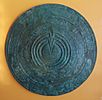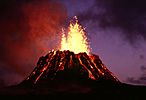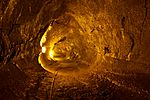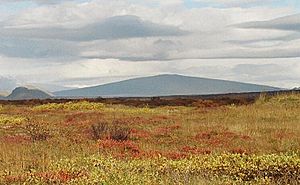Shield volcanoes facts for kids
A shield volcano is a type of volcano that looks like a warrior's shield lying on the ground. It has a wide, gently sloping shape. These volcanoes form when very runny (low viscosity) lava erupts. This runny lava flows easily and spreads out far, creating thin layers. Over time, many eruptions build up these broad layers of lava, giving the shield volcano its unique shape.
You can find shield volcanoes anywhere that runny, low-silica lava reaches the surface of a rocky planet. They are very common on volcanic islands that form over hot spots, like Hawaii. They also appear where the Earth's crust is pulling apart, in continental rift zones. Some of the biggest volcanoes on Earth are shield volcanoes, such as Tamu Massif and Mauna Loa. Huge shield volcanoes are also found on other planets in our Solar System, like Olympus Mons on Mars and Sapas Mons on Venus.
|
|
|
| Diagram of the common structural features of a shield volcano |
Shield volcanoes often have lava tubes. These are like natural tunnels or caves formed when the outside of a lava flow hardens, but the lava inside keeps flowing. Lava tubes are important because their walls keep the lava warm, allowing it to travel even further. For example, about 58% of the lava that built Kīlauea volcano in Hawaii came from lava tubes.
Sometimes, basaltic lava from a shield volcano erupts from a long crack in the ground, called a fissure, instead of a central opening. This lava spreads out, covering the land in a wide band and forming a large, flat area called a plateau. You can see these lava plateaus in places like Iceland, Washington, Oregon, and Idaho. The most famous ones are along the Snake River in Idaho and the Columbia River in Washington and Oregon. Some of these plateaus are over 1.6 kilometers (1 mile) thick!
Calderas are also common on shield volcanoes. A caldera is a large, bowl-shaped hollow that forms when the ground collapses after a big eruption. These calderas can form and reform many times during a volcano's life. Long periods of eruptions can create smaller cone-shaped hills called cinder cones, which then collapse to form calderas. New eruptions often fill these calderas, or new ones form nearby. This cycle of collapse and rebuilding happens throughout the volcano's active life.
When water mixes with lava during a shield volcano eruption, it can cause an explosive hydrovolcanic eruption. These eruptions are very different from the usual gentle lava flows of shield volcanoes. They happen a lot at volcanoes surrounded by water, like those in the Hawaiian Islands.
-
Mauna Loa, a shield volcano in Hawaii
-
An Ancient Greek warrior's shield—its circular shape and gently sloping surface, with a central raised area, is a shape shared by many shield volcanoes.
-
A pāhoehoe lava fountain erupting on Kīlauea
-
Pāhoehoe lava flows entering the Pacific Ocean on Hawaiʻi island
-
Nāhuku, a lava tube on Hawaiʻi island, now a tourist attraction in the Hawaiʻi Volcanoes National Park
Contents
Where are Shield Volcanoes Found?
Shield volcanoes are found all over the world. They can form over hotspots, which are places where hot magma rises from deep inside the Earth. Examples include the Hawaiian–Emperor seamount chain and the Galápagos Islands. They can also form over rift zones, where Earth's plates are pulling apart, like the Icelandic shields and volcanoes in East Africa.
Even though shield volcanoes are not usually linked to subduction zones (where one plate slides under another), some can be found there. Many examples are in California and Oregon, including Prospect Peak in Lassen Volcanic National Park, and Pelican Butte and Belknap Crater in Oregon. Many shield volcanoes are in ocean basins, like Tamu Massif, the world's largest. But they can also be found inland, with East Africa being a good example.
The Hawaiian Islands: A Famous Hotspot Chain
The biggest and most well-known chain of shield volcanoes in the world is the Hawaiian–Emperor seamount chain. This is a long line of hotspot volcanoes in the Pacific Ocean. These volcanoes follow a clear pattern of growing and then becoming inactive. The chain has at least 43 large volcanoes. The Meiji Seamount, at the very end of the chain near the Kuril–Kamchatka Trench, is 85 million years old.
The youngest part of this chain is Hawaii itself. The volcanoes here often have eruptions along long cracks called rift zones. They are very large, sometimes thousands of cubic kilometers in size. The movement of the Pacific Plate over the Hawaii hotspot fuels these volcanoes. This creates a long chain of volcanoes, atolls (ring-shaped coral reefs), and seamounts (underwater mountains) that stretches 2,600 kilometers (1,600 miles) and has a total volume of over 750,000 cubic kilometers (180,000 cubic miles).
The chain includes Mauna Loa, a huge shield volcano that stands 4,170 meters (13,680 feet) above sea level. It also reaches another 13 kilometers (8 miles) below the water and into the Earth's crust, containing about 80,000 cubic kilometers (19,000 cubic miles) of rock. Kīlauea, another Hawaiian shield volcano, is one of the most active volcanoes on Earth. Its most recent eruption was in 2021.
Galápagos Islands: Volcanic Wonders
The Galápagos Islands are a group of isolated volcanoes, including shield volcanoes and lava plateaus. They are about 1,100 kilometers (680 miles) west of Ecuador. These islands are formed by the Galápagos hotspot and range in age from about 4.2 million to 700,000 years old. The largest island, Isabela, is made up of six shield volcanoes that have grown together. Each one has a large caldera at its top. Española, the oldest island, and Fernandina, the youngest, are also shield volcanoes, as are most of the other islands in the chain.
The Galápagos Islands sit on a large lava plateau called the Galápagos Platform. This platform makes the water around the base of the islands shallow, from 360 to 900 meters (1,180 to 2,950 feet) deep. The islands spread out over an area 280 kilometers (174 miles) wide. Since Charles Darwin visited the islands in 1835, there have been over 60 recorded eruptions from six different shield volcanoes. Out of 21 volcanoes that rise above the sea, 13 are still considered active.
Cerro Azul is a shield volcano on the southwestern part of Isabela Island. It is one of the most active volcanoes in the Galapagos, with its last eruption between May and June 2008. The Geophysics Institute in Quito has a team of seismologists (who study earthquakes) and volcanologists (who study volcanoes). They monitor Ecuador's many active volcanoes in the Andes Mountains and the Galapagos Islands. La Cumbre is an active shield volcano on Fernandina Island that has been erupting since April 11, 2009.
Iceland: Land of Fire and Ice
Iceland is located over the Mid-Atlantic Ridge, which is a divergent tectonic plate boundary in the middle of the Atlantic Ocean. This means the Earth's plates are pulling apart here. Iceland has about 130 different types of volcanoes. Most Icelandic shield volcanoes are from the Holocene age, meaning they are between 5,000 and 10,000 years old. These volcanoes are found in two narrow bands in the West and North Volcanic Zones. Like Hawaiian volcanoes, they often start with several eruption spots before focusing on one main point. The main shield volcano then grows, covering the smaller ones that formed earlier.
Icelandic shield volcanoes are usually small, about 15 cubic kilometers (3.6 cubic miles) in size. They are also symmetrical, though the land around them can affect their shape. Their eruptions usually come from calderas at their tops. They are made of a type of basalt rock called tholeiitic olivine or picritic basalt. The tholeiitic shields tend to be wider and shallower than the picritic ones. Unlike other shield volcanoes, their calderas might form but usually do not disappear.
East Africa: Rift Valley Volcanoes
In East Africa, volcanoes are formed by the East African Rift, where the continent is slowly splitting apart, and by nearby hotspots. Some volcanoes are affected by both. Shield volcanoes are found near the rift and off the coast of Africa, though stratovolcanoes are more common there. These volcanoes haven't been studied as much, but the fact that all of them are from the Holocene age shows that this volcanic area is quite young. One interesting thing about East African volcanoes is that they often form lava lakes. These semi-permanent pools of lava are very rare elsewhere but happen in about 9% of African eruptions.
The most active shield volcano in Africa is Nyamuragira. Its eruptions usually happen inside its large caldera at the top or from the many cracks and cinder cones on its sides. Lava flows from the last century have traveled more than 30 kilometers (19 miles) down its sides, reaching as far as Lake Kivu. Erta Ale in Ethiopia is another active shield volcano. It is one of the few places in the world with a permanent lava lake, which has been active since at least 1967, and possibly since 1906. Other volcanic areas include Menengai, a huge shield caldera, and Mount Marsabit in Kenya.
Shield Volcanoes Beyond Earth
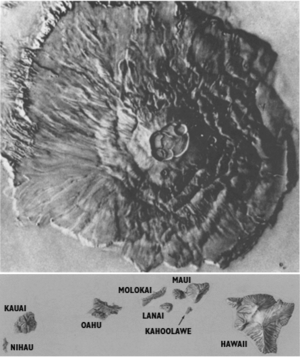
Shield volcanoes are not just found on Earth! They have also been discovered on Mars, Venus, and Jupiter's moon, Io.
The shield volcanoes of Mars are very similar to Earth's. On both planets, they have gentle slopes, collapse craters at their center, and are built from very fluid lavas. Scientists observed volcanoes on Mars long before they were studied closely during the 1976–1979 Viking mission. The main difference between Martian volcanoes and Earth's is their size. Martian volcanoes can be up to 14 kilometers (9 miles) high and 600 kilometers (370 miles) wide. This is much larger than the 6-kilometer (4-mile) high, 120-kilometer (74-mile) wide Hawaiian shields. The tallest of these, Olympus Mons, is the highest known mountain on any planet in our solar system.
Venus has over 150 shield volcanoes. These are much flatter and cover a larger area than those on Earth. Some have a diameter of more than 700 kilometers (430 miles). Most of these volcanoes are no longer active, but observations from the Venus Express spacecraft suggest that many might still be erupting.




